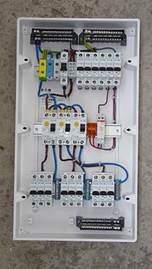House Electrician

Single-phase ~230 V/40 A/9 kW fuse box for apartment rewiring. Each appliance and each room are highlighted into autonomous circuits – this apartment has 14 individual circuits. A relay is used to control the light fixtures in a large room.
Homes typically have several kinds of home wiring, including electrical wiring for lighting and power distribution, permanently installed and portable appliances, telephone, heating or ventilation system control, and increasingly for home theatre and computer networks.
Safety regulations for wiring installation vary widely around the world, with national, regional, and municipal rules sometimes in effect. Some places allow the homeowner to install some or all of the wiring in a home; other jurisdictions require electrical wiring to be installed by licensed electricians only.
Typical features
In new home construction, wiring for all electrical services can be easily installed before the walls are finished. In existing buildings, installation of a new system, such as a security system or home theatre, may require additional effort to install concealed wiring. Multiple unit dwellings such as condominiums and apartment houses may have additional installation complexity in distributing services within a house.
Services commonly found include:
- Power points (wall outlets)
- Light fixtures and switches
- Telephone
- Internet
- Television, either broadcast, cable, or satellite
High-end features might include:
- Home theater
- Distributed audio
- Security monitoring
- Security CCTV
- Automation
- Energy management
Power and telecommunication services generally require entry points into the home and a location for connection equipment. For electric power supply, a cable is run either overhead or underground into a distribution board in the home. A distribution board, or circuit breaker panel, is typically a metal box mounted on a wall of the home. In many new homes the location of the electrical switchboard is on the outside of the external wall of the garage.
How services are connected will vary depending on the service provider and location of the home.
The following home services are supported by discrete wiring systems
- Information and Communications
- Entertainment
- Energy Management
- Security and Safety
- Digital Home Health
- Aged and Assisted Living
- Intelligent Lighting and Power.








